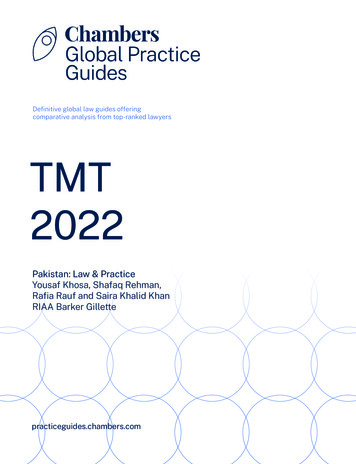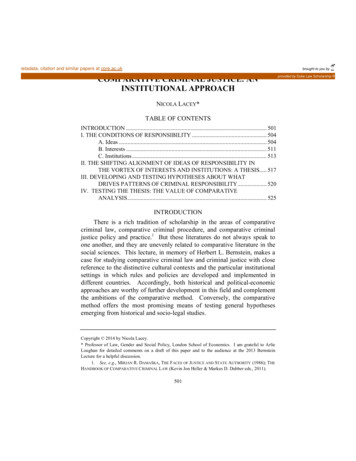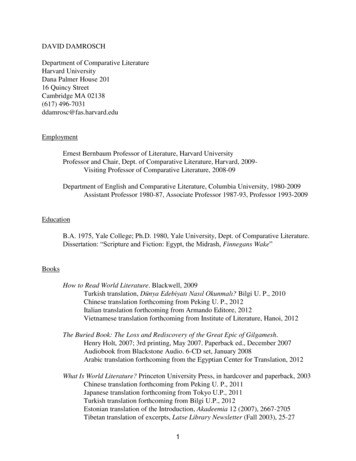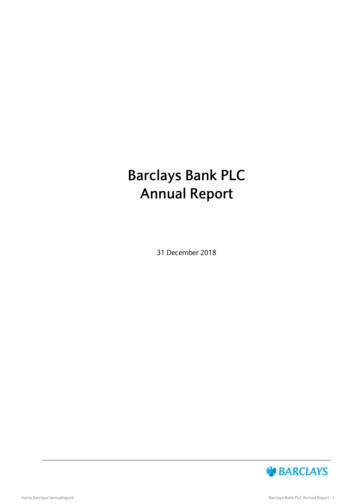
Transcription
Definitive global law guides offeringcomparative analysis from top-ranked lawyersSecuritisation2022India: Law & PracticeSonali Mahapatra, Rituparno Bhattacharya,Tanay Agarwal and Ankit SharmaTT&Apracticeguides.chambers.com
INDIALaw and lhiContributed by:Sonali Mahapatra, Rituparno Bhattacharya,Tanay Agarwal and Ankit SharmaTT&A see p.19Sri LankaCONTENTS1. Structurally Embedded Laws of GeneralApplicationp.31.1 Insolvency Lawsp.31.2 Special-Purpose Entities (SPEs)p.31.3 Transfer of Financial Assetsp.31.4 Construction of Bankruptcy-RemoteTransactionsp.52. Tax Laws and Issuesp.52.1 Taxes and Tax Avoidancep.52.2 Taxes on SPEsp.52.3 Taxes on Transfers Crossing Bordersp.52.4 Other Taxesp.52.5 Obtaining Legal Opinionsp.63. Accounting Rules and Issuesp.63.1 Legal Issues with Securitisation AccountingRulesp.63.2 Dealing with Legal Issuesp.64. Laws and Regulations SpecificallyRelating to Securitisationp.64.1 Specific Disclosure Laws or Regulationsp.64.2 General Disclosure Laws or Regulationsp.74.3 Credit Risk Retentionp.74.4 Periodic Reportingp.84.5 Activities of Rating Agenciesp.94.6 Treatment of Securitisation in Financial Entities p.104.7 Use of Derivativesp.104.8 Investor Protectionp.104.9 Banks Securitising Financial Assetsp.114.10 SPEs or Other Entitiesp.124.11 Activities Avoided by SPEs or OtherSecuritisation Entitiesp.124.12 Material Forms of Credit Enhancementp.124.13 Participation of Government-SponsoredEntitiesp.124.14 Entities Investing in Securitisationp.125. Documentationp.135.1 Bankruptcy-Remote Transfersp.135.2 Principal Warrantiesp.135.3 Principal Perfection Provisionsp.145.4 Principal Covenantsp.145.5 Principal Servicing Provisionsp.155.6 Principal Defaultsp.155.7 Principal Indemnitiesp.166. Roles and Responsibilities of thePartiesp.166.1 Issuersp.166.2 Sponsorsp.166.3 Underwriters and Placement Agentsp.166.4 Servicersp.166.5 Investorsp.166.6 Trusteesp.177. Synthetic Securitisationp.177.1 Synthetic Securitisation Regulation andStructurep.178. Specific Asset Typesp.178.1 Common Financial Assetsp.178.2 Common Structuresp.179. Impact of COVID-19p.179.1 Pandemic-Related Legal Issuesp.172
INDIA Law and PracticeContributed by: Sonali Mahapatra, Rituparno Bhattacharya, Tanay Agarwal and Ankit Sharma, TT&A1 . S T R U C T U R A L LYEMBEDDED LAWS OFG E N E R A L A P P L I C AT I O N1.1 Insolvency LawsSecuritisation in India involves a sale of assetsto bankruptcy remote entities thereby insulating such assets from any insolvency risk of theoriginator. The special purpose entity (typicallya trust) itself has no credit exposure and doesnot engage in any other economic activity. Thetransfer of assets is carried out such that thelegal title of the assets along with the financialrisk and reward from such assets is transferredto the SPE while the originator of the assets isallowed to retain a limited amount of exposure(including any exposure on account of creditenhancements). Accordingly, in the case ofthe insolvency of the originator, the underlyingassets and the receivables therefrom are not apart of the insolvency estate.1.2 Special-Purpose Entities (SPEs)Securitisation transactions by banks and nonbanking financial entities (NBFI) are regulatedby the Reserve Bank of India (RBI) under theReserve Bank of India (Securitisation of StandardAssets) Master Direction, 2021 (RBI SSA Directions). These directions were recently introducedto replace the existing regime, and are requiredto be complied with by banks and NBFIs securitising their loans. Under the RBI SSA Directions,the SPE can be organised as a company, a trustor any other legal entity. Typically, in India, SPEsare organised as non-discretionary private trustssettled by trusteeship companies (engaged forthe purpose of the transaction) in favour of themselves as the trustee. Investors, as beneficiariesof such a trust, have an undivided interest in itsassets (on account of being holders of securitisation notes issued by the trust). The requiredand desirable aspects of an SPE are as follows:3 the name of the SPE should be distinct andunconnected with the name of the originator; the originator should not have any economicor proprietary interest in the SPE – the beneficial interest of originator should be restrictedto permitted exposures (see 4.12 MaterialForms of Credit Enhancement for moredetails); the originator should not be permitted tohave more than one representative without aveto power in a board of at least four members (with independent members forming themajority); the originator should not be permitted toexercise direct or indirect control over theSPE or its trustees; the constituting document (being the trustsettlement deed) should set out the specificpurpose of the trust, the rights and dutiesof the trustee and the voting mechanism fordecision making; the trustee should not have any discretionarypower, and the investors should be permittedto substitute the trustee at any point in time; the SPE should disclose, specifically to theinvestors, that the securitisation notes are notin the nature of a deposit obligation of theoriginator; and all transactions between the originator of theassets and the SPE should be on an arm’slength basis.1.3 Transfer of Financial AssetsInstrument of TransferTo transfer the legal title of the underlying assets,the originator enters into a deed of assignmentin favour of the SPE. Applicable stamp taxes arerequired to be paid on such a deed of assignment. In the event that consent from/notice tothe underlying obligors is required, the samewill have to be obtained/completed prior to theassignment. However, underlying documentstypically allow for assignment without the need
Law and Practice INDIAContributed by: Sonali Mahapatra, Rituparno Bhattacharya, Tanay Agarwal and Ankit Sharma, TT&Afor an intimation to or consent from the underlying obligors.Registry of Securitisation Asset Reconstructionand Security Interest of India (CERSAI).Taxes on TransferWhile transfer of receivables by way of assignment is treated at par with any conveyanceand certain states in India have an uncappedstamp duty (typically in the range of 2% to 5%),some of the other states have provided a specific concession for transfer of loan receivablesand capped the stamp taxes to INR100,000(for example, in the States of Maharashtra andDelhi).Derecognition under RBI SSA DirectionsUnder the RBI SSA Directions, upon satisfaction of the following conditions, the transferredassets are derecognised as exposures of theoriginator and therefore the originator will not berequired to maintain capital against the transferred assets.FormalitiesIn the event the underlying loan assets have thebenefit of security from a company and the security interest is created and registered in favour ofthe originator (and not a trustee holding it for anyholder of the financial asset), the same will haveto be registered in the name of the SPE in therecords of the relevant Registrar of Companies.This process is completed by filing an onlineform for modification of charge registration bythe security provider.In the event the underlying loan assets have thebenefit of security over immoveable propertyand the security interest is created and registered in favour of the originator (and not a trusteeholding it for any holder of the financial asset),the assignment deed transferring such a securityinterest will have to be registered at the officeof the relevant sub-registrar of assurances andadditional stamp taxes may be applicable basedon the jurisdiction of such an asset.Separately, in terms of the Securitisation andReconstruction of Financial Assets and Enforcement of Security Interest Act, 2002 (SARFAESI),all banks and secured creditors (being certainNBFIs and financial institutions) are required toregister their security interest with the Central The originator should not have direct or indirect control over the transferred exposuresincluding by way of an obligation to repurchase or any other contractual undertaking toretain the risk. Clean up call options under thefollowing conditions are allowed:(a) the option should be voluntary and exercisable at arm’s length, and only whenless than 10% of the obligations under thesecuritisation notes are due;(b) exercise of the option should be subjectto internal review processes of the originator; and(c) the option should not be structured toavoid allocating risk to the senior trancheholders or the credit enhancement. The exposures should be legally transferredfrom the originator (see requirements above). The originator should not have any obligationunder the securitisation notes (other than permitted credit enhancement, see 4.12 MaterialForms of Credit Enhancement). Securitisation notes should be freely transferable and the investors should be able toencumber the same without any restriction. In structures where the originator is permitted to replenish assets, there should be norequirement to replenish so as to improve thecredit quality of the underlying assets. There should be no additional yield payableon account of deterioration of credit quality ofassets.4
INDIA Law and PracticeContributed by: Sonali Mahapatra, Rituparno Bhattacharya, Tanay Agarwal and Ankit Sharma, TT&A Termination of securitisation is permitted onlyin case of an early amortisation in a replenishment structure or on account of regulatorychanges or exercise of clean-up call option. The originator is required to obtain a legalopinion certifying the satisfaction of the aforesaid conditions to achieve derecognition.1.4 Construction of BankruptcyRemote TransactionsPlease refer to 1.3 Transfer of Financial Assets.2 . TA X L A W S A N D I S S U E S2.1 Taxes and Tax AvoidanceThe income arising from the transfer of assets istaxable in the hands of originator under IncomeTax Act, 1961 (IT Act). Income tax for corporateentities under the IT Act ranges from 25% to42% inclusive of the applicable surcharges payable.In India, an SPE set up for securitisation underthe RBI SSA Directions will be considered as apass-through entity for taxation and any incomearising or accruing to it will be taxed in the handsof the investor of the securitisation notes as ifthe income were directly received by it. SPEs arerequired to make a deduction of tax at sourcebefore distributing any income to the investors,whether resident or non-resident (other than theinvestors whose income is exempt from beingtaxed for securitisation transactions) at the following rates: 25% on income distributed to any personbeing a resident individual or a resident HinduUndivided Family; 30% on income distributed to any other resident person; and at rates in force applicable to the foreigninvestor (determined based on applicableregime to the foreign investor and the double5taxation avoidance agreement (DTAA) withthe respective jurisdiction).Furthermore, Section 197 of the IT Act stipulates that if an investor is able to obtain a certificate from the assessing officer, for deductionat source at a percentage lesser than the percentages stipulated above or for nil deduction,the securitisation trust will have to deduct tax atsuch lower rates or will not be required to deductany tax, as the case may be.Foreign investors will be taxed at the applicablerates in force determined based on the type ofpayment (whether interest or redemption proceeds), their jurisdiction, and applicable DTAA.This section reflects the general understandingof tax implications in securitisation and specifictax advice will have to be obtained by originatorsand investors based on their type, constitutionand jurisdiction.2.2 Taxes on SPEsSee 2.1 Taxes and Tax Avoidance.2.3 Taxes on Transfers CrossingBordersSee 2.1 Taxes and Tax Avoidance.2.4 Other TaxesThe key tax issues have been set out in 2.1 Taxes and Tax Avoidance. Furthermore, depending on (i) the structure of underlying asset pooland return parameters, (ii) the type of creditenhancement, (iii) the treatment of excessinterest spread, and (iv) the constitution of theinvestor (including form, jurisdiction and type ofinvestor), additional issues around tax treatmentof the cash-flows may arise from time to time.Investors and originators should obtain specifictax advice in respect of these issues.
Law and Practice INDIAContributed by: Sonali Mahapatra, Rituparno Bhattacharya, Tanay Agarwal and Ankit Sharma, TT&A2.5 Obtaining Legal OpinionsTax opinions are obtained by originators andinvestors at the time of structuring the transaction. These opinions typically assume the factualaspects of the transaction and that the transaction will be a securitisation transaction which issubject to the specific regime set out in the ITAct. For this purpose, in the case of standardassets, the transaction will have to comply withthe RBI SSA Directions.3. ACCOUNTING RULESAND ISSUES3.1 Legal Issues with SecuritisationAccounting RulesThe RBI SSA Directions prescribe for minimumcriteria to be met for derecognition of assetsfor maintaining capital exposures. Derecognition of assets from an accounting purpose canbe achieved only if the requirements under theapplicable accounting standards are met (whichmay not always be the case, even though therequirements under the RBI SSA Directions aremet, as the accounting standards provide forstricter requirements for derecognition and nonconsolidation of the SPE).In India, securitisation transactions are undertaken by banks and NBFIs primarily to achieverelief from maintaining capital exposures, andthey may or may not achieve an off-balancesheet treatment for the transferred assets in allcases. In cases where off-balance sheet treatment is the principal driver for the transaction,specific structuring advise will be required fromaccounting practitioners.One of the legal issues arising from this dichotomy is that under the Insolvency and BankruptcyCode, 2016 (IBC), if the securitisation transaction does not lead to an off-balance sheet treatment for the assets, the insolvency professional/liquidator of the originator, may, in the case ofthe originator’s insolvency make a preliminarydetermination that the assets form a part of theoriginator’s estate which finding will then have tobe challenged before the adjudicating authority.Given that the deed of assignment achieves afull legal transfer of the title over the assets, thechallenge is very likely to succeed.3.2 Dealing with Legal IssuesAs set out in 1.3 Transfer of Financial Assets,the originator is required to obtain a legal opinionin respect of the derecognition criteria in order towrite off the capital exposure to the assets underthe RBI SSA Directions. These opinions carry thesame qualifications as would any other closingopinions issued in India for a debt transactionwith the exception that the qualification on applicability of insolvency laws to enforcement is limited to voidable transactions such as preferentialtransfers to creditors, undervalued transactionsand fraudulent transfers, which affect enforceability instead of generally qualifying the opinionas subject to bankruptcy laws.In relation to any other facilities being providedby any person including the originator, the service provider is required to obtain a legal opinionthat the terms of its engagement protect it fromany liability to the investors or to the SPE save tothe extent of its contractual obligations.4. LAWS ANDR E G U L AT I O N SS P E C I F I C A L LY R E L A T I N GT O S E C U R I T I S AT I O N4.1 Specific Disclosure Laws orRegulationsThe general disclosure requirements in relationto securitisation transactions are stipulated inthe RBI SSA Directions. Separately, listing ofsecuritisation notes is governed by the Securi6
INDIA Law and PracticeContributed by: Sonali Mahapatra, Rituparno Bhattacharya, Tanay Agarwal and Ankit Sharma, TT&Aties and Exchange Board of India (SEBI) underthe and Securities and Exchange Board of India(Public Offer and Listing of Securitised DebtInstruments) Regulations, 2008, as amendedfrom time to time (SEBI SDI Regulations) whichprovides for additional disclosure requirementsif the notes are proposed to be listed.Disclosures under RBI SSA DirectionsThe RBI SSA Directions stipulate the disclosuresrequired to be made by parties to the securitisation such as originator, servicer, etc. Some ofthe key disclosure requirements are listed below: weighted average holding period of theassets securitised; the level of minimum retention requirementstipulated in RBI SSA Directions and actualretention; material data on cash flows, collateral supporting a securitisation exposure and information necessary to conduct stress tests onthe cash flows and collateral value supportingthe underlying exposure; maturity characteristics of the underlyingassets such as weighted average maturity,maturity wise distribution, etc; credit quality of the underlying loans such asdistribution of overdue loans, rating wise distribution of the underlying loans, prepaymentrules, etc; and other characteristics of the loan pool such asindustry wise break-up of the loans in case ofmixed pools, geographical distribution of theloan pool, etc.Disclosure under SEBI SDI RegulationsThe disclosure requirements in relation to listingof securitised debt instruments and public issueof such instruments are stipulated in the SEBISDI Regulations. Some of the key disclosuresunder SEBI SDI Regulations are listed below: description of the structure of the transaction;7 credit enhancement and liquidity support; excess spread and the treatment thereof; important structural triggers in the transactionsuch as early amortisation, trapping of excessspreads, etc; priority of distributions and allocation offunds; material features of the asset pool such asdefault rate, recovery rate, prepayment rate,etc; major representations and warranties contained in the document whereby the assethas been assigned; details of the servicer such as name of theservicer, its organisational form, experience,its fees, its duties, etc; details of the originator such as name, principal business activities, market presence,financial information concerning originator’sassets and liabilities, etc; details of the trustees such as name, organisational form, management, its duties, powers, procedure for appointment, etc; and details of the issuer such as description, themanagement and persons in control of theissuer, persons holding residual beneficialinterest in the issuer, financial informationconcerning its assets and liabilities, etc.4.2 General Disclosure Laws orRegulationsSee 4.1 Specific Disclosure Laws or Regulations.4.3 Credit Risk RetentionThe RBI SSA Directions stipulate seasoning andminimum credit risk retention requirements forbanks and financial institutions.The RBI has prescribed the following minimumholding periods (MHP): three months for loans with tenor of up to twoyears and six months for other loans from the
Law and Practice INDIAContributed by: Sonali Mahapatra, Rituparno Bhattacharya, Tanay Agarwal and Ankit Sharma, TT&Adate of registration of the underlying securityinterest (or date of first repayment, wherethere is no security); in the case of project loans, six months fromdate of commencement of commercial operations; and for loans acquired from other entities, sixmonths from the date of transfer.The RBI SSA Directions provide for the following minimum retention requirement (MRR) by theoriginator of the assets which are being securitised to ensure that originators continue to haveexposure to the loans being securitised andtherefore carry out proper due diligence at thetime of originating such loans: an MRR of 5% for loans with original maturityof up to 24 months and 10% for loans withlonger maturity or with bullet repayments; and an MRR of 5% for residential mortgagebacked securities.The information, reports and auditor’s certificates, as received from the originator or its auditors, are required to be made available to thecredit rating agency.Reporting Requirements under RBI SSADirectionsIn the event the originator changes its originating standards between the time of loan origination and the time that all the claims associatedwith the securitisation notes are paid off, suchchanges must be disposed to investors in thesecuritisation notes.In the event there is a breach, the status inrespect of the expected cash flows to the noteholders, the ability for the breach to be reversedand the consequences of the breach should beclearly identified in the investor report.4.4 Periodic ReportingThe originator is required to notify the RBI ofall the instances where it has agreed to replaceassets sold to the SPE or pay damages arisingout of any representation or warranty.Reporting Requirements under SEBI SDIRegulationsThe originator is required to provide periodicreports (such as cash flow reports and paymentreports) on a quarterly basis to the SPE which inturn provides the same to the investors.Wherever a third-party servicer is appointed,the originator is required to ensure that there arerobust and legally binding information-sharingarrangements in place to comply with stipulatedreporting requirements with requisite frequencyand rigour. In cases where data is obtained fromthird party entities, the originator must get information duly certified by the respective third-party auditors, preferably at least once a calendaryear.Both RBI SSA Directions and SEBI SDI Regulations specify the periodic reporting obligationsfor the various parties involved in a securitisation.The servicer is required to confirm to the investors as to its compliance with its obligations ona quarterly basis.The originator is required to provide a quarterlycertificate from its auditor regarding the disclosures made by the originator to the SPE inrespect of the underlying pool.The disclosure in relation to the originator’s fulfilment of MHP and MRR should be made at theorigination of the transaction and is required tobe confirmed thereafter, at a minimum, biannually (by the end of September and March) andat any point where the requirement is breached.The aforesaid periodical disclosure is requiredto be made for each securitisation separately8
INDIA Law and PracticeContributed by: Sonali Mahapatra, Rituparno Bhattacharya, Tanay Agarwal and Ankit Sharma, TT&Athroughout its life, in the servicer report, investor report, trustee report or any similar documentpublished.Originators are required to disclose the detailsof the securitisation transactions to the RBI onquarterly basis.Enforcement and PenaltiesThe RBI is the primary regulator for securitisation transactions by banks and NBFIs and isthe enforcement agency in relation to RBI SSADirections. Under the securitisation regime priorto the RBI SSA Directions, securitisation transactions which did not comply with the criteriaset out under the regulations were not expressly prohibited and therefore the general marketposition was that such transactions could beundertaken provided the originator continuedto maintain capital exposure in respect of thetransferred assets.Under the RBI SSA Directions and the RBI TLEDirections, any assignment transaction thatdoes not comply with the requirements underthe said directions not only leads to the originators having to maintain capital exposures but isalso expressly prohibited.Enforcement and regulation in relation to listedsecuritised debt instruments is governed bySEBI. In the event of a breach of the SEBI SDIRegulations, the registration of relevant trusteecan be cancelled.4.5 Activities of Rating AgenciesCredit rating agencies (RAs) in India are governed by the SEBI (Credit Rating Agencies)Regulations, 1999 (SEBI CRA Regulations). TheSEBI CRA Regulations govern RAs in respect ofall securities and there is no specific law in Indiathat governs RAs in relation to securitisation.9The SEBI CRA Regulations specify the minimumconditions required to be met by an entity to getitself registered as an RA in India. Furthermore,SEBI CRA Regulations require RAs to enter intoa written agreement with the client whose securities it proposes to review, to continuously monitor the rating of the securities rated by it, to carryout periodic reviews of all published ratings, etc.The RBI SSA Directions also provide for creditassessment of the securitisation notes by external credit rating agency subject to compliancewith following conditions. The external credit assessment has to befrom an eligible external credit rating agencyas provided in paragraph 6 of the MasterCircular – Basel III Capital Regulations dated1 July 2015; the rating is required to be published on a publicly accessible platform andshould also be included in the RA’s transitionmatrix. Eligible RAs must demonstrate expertise inassessing securitisations. The external credit assessment must takeinto account and reflect the entire amountof credit risk exposure the lender has withregard to all payments owed to it. A lender is not permitted to use any externalcredit assessment for risk weighting purposeswhere the assessment is at least partly basedon unfunded support provided by the lender.The SEBI CRA Regulations stipulate that in theevent that an RA fails to comply with the provisions of the SEBI Act, any rules made thereunderor with the provisions of SEBI CRA Regulations,it shall be liable for inquiry and penal action(leading to payment of penalties or cancellationof licence) by the SEBI.
Law and Practice INDIAContributed by: Sonali Mahapatra, Rituparno Bhattacharya, Tanay Agarwal and Ankit Sharma, TT&A4.6 Treatment of Securitisation inFinancial EntitiesBanks and financial institutions are entitled toenter into OTC derivatives and exchange-traded derivatives. The typical derivative productsentered into in respect of securitisation transactions are OTC derivatives such as interest rateswaps and forward rate agreements (with interest rate options also available) and exchangetraded derivatives such as interest rate futures.In the case of securitisation transactions whichsatisfy the criteria prescribed by the RBI for simple, transparent and comparable securitisationtransaction (based on the prescriptions of theBasel Committee on Banking Supervision) (STCTransaction), alternative and more favourablecapital treatment has been made available toinvestors (being banks, NBFIs and other institutions regulated by the RBI) in such notes. Theoriginator is required to disclose necessaryinformation to allow investors to determine if thetransaction is an STC Transaction before applying the alternative treatment.4.8 Investor ProtectionLenders are required to maintain capital againsttheir entire securitisation exposure as per theapplicable directions of the RBI. The RBI hasprovided for separate mechanisms for computing risk weights in the case of unrated and ratedsecuritisation notes.4.7 Use of DerivativesThere is no specific regulation governing the useof derivatives in relation to securitisation transactions.Over-the-counter (OTC) interest rate and foreigncurrency derivatives in India are regulated by theRBI and governed by the Comprehensive Guidelines on Derivatives dated 20 April 2007 (whichwill be repealed by the Reserve Bank of India(Market-makers in OTC Derivatives) Directions,2021 with effect from 3 January 2022). Both theexisting guidelines and the new directions permit eligible users (including banks and financialinstitutions) that have a genuine underlying riskto enter into derivative contracts.Exchange-traded interest rate and foreign currency derivatives are regulated by the RBI andSEBI.Both RBI SSA Directions and SEBI SDI Regulations specify requirements aimed at investorprotection. Some of the key requirements areas follows.Requirements under RBI SSA DirectionsThe originator is required to retain a certainportion of credit risk in the securitised pool bycomplying with MRR requirements as detailed insection 4.3 Credit Risk Retention.Underwriting standards for securitised exposures are required to be the same and as stringent as those applied to the retained exposuresof the originator. In case of securitised exposures which are acquired by originators fromother lenders, the originator is required to applythe same standards of due diligence as its own.The originator is required to disclose sufficientloan-level data to investors to ensure that theinvestors are able to conduct appropriate duediligence prior to investment.In order to protect investors from being subjected to unexpected repayment profiles duringthe life of a securitisation, the documents shouldclearly specify the priorities of payments for allliabilities in all circumstances and appropriatelegal comfort should be provided regarding theirenforceability.All triggers affecting the cashflow waterfall, payment profile or priority of payments should be10
INDIA Law and PracticeContributed by: Sonali Mahapatra, Rituparno Bhattacharya, Tanay Agarwal and Ankit Sharma, TT&Aclearly documented and disclosed in the offerdocument in order to provide investors withtransparency.The trust deed should empower the investors tochange the trustee at any point of time.The originator is required to ensure that prospective investors have access to informationon the credit quality, cash flows and collateralsupporting a securitisation exposure and information necessary to conduct stress tests on thecash flows and collateral value supporting theunderlying exposure.Where investors are banks, NBFIs and financialinstitutions regulated by the RBI the RBI hasstipulated additional criteria for assessment anddiligence to be followed by them prior to investment in securitised notes.Requirements under SEBI SDI RegulationsPlease refer to the disclosure and periodicreporting requirements in 4.1 Specific Disclosure Laws or Regulations and 4.4 PeriodicReporting. Additionally: the trustee is required to take adequate stepsfor redressal of grievances of the investorswithin one month of the date of the
by the Reserve Bank of India (RBI) under the Reserve Bank of India (Securitisation of Standard Assets) Master Direction, 2021 (RBI SSA Direc-tions). These directions were recently introduced to replace the existing regime, and are required to be complied with by banks and NBFIs secu-ritising their loans. Under the RBI SSA Directions,











